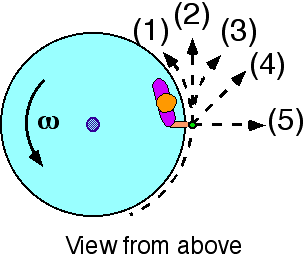A2L Item 067
- Description: Identify the conserved quantities when a rock is thrown radially from a rotating platform.
- Goal: Recognize physical conditions under which conservation principles hold.
- Source: UMPERG-ctqpe144
- Keywords: Conservation, Forces, Mechanics, Rotational Motion
The question for students:
 A
child is standing at the rim of a rotating disk holding a rock. The
disk rotates without friction. The rock is thrown in the RADIAL
direction at the instant shown. What quantities are conserved during
this process?
A
child is standing at the rim of a rotating disk holding a rock. The
disk rotates without friction. The rock is thrown in the RADIAL
direction at the instant shown. What quantities are conserved during
this process?
- Only angular momentum is conserved.
- Only mechanical energy is conserved.
- Both angular momentum and mechanical energy are conserved.
- Neither is conserved.
- cannot be determined.
Commentary for teachers:
Answer
(1) is the correct response if the rock is thrown radially. The change in velocity of the rock and, therefore its change in momentum, is in the radial direction. The net torque on the system is zero so the angular momentum cannot change. Some students may be tempted to choose (3) but, since the rock is thrown via biological processes (as opposed to mechanical processes), mechanical energy is not conserved.
Background
Throwing the rock radially, clearly increases the kinetic energy but not the angular momentum. This item provides a mechanism for a rich discussion of the source of the kinetic energy.
Questions to Reveal Student Reasoning
Does the rock have angular momentum (or energy) just before it is thrown? just after it is thrown?
If energy (angular momentum) is gained, where does it come from?
Changes in angular momentum are caused by a net torque. What torques act on the system during the process of throwing?
Suggestions
Have the students do a ‘thought’ experiment by considering a spring loaded gun mounted on a rotating turntable aimed outward along a radius. The spring is released firing a small ball outward. This situation makes it easier for some students to identify the source of additional kinetic energy. Further, since the force applied is parallel to the radius, there is no angular impulse and no change in angular momentum in the system. Have students relate their answer to this question to the previous one. Also contrast this and the previous one to items 64 and 65.